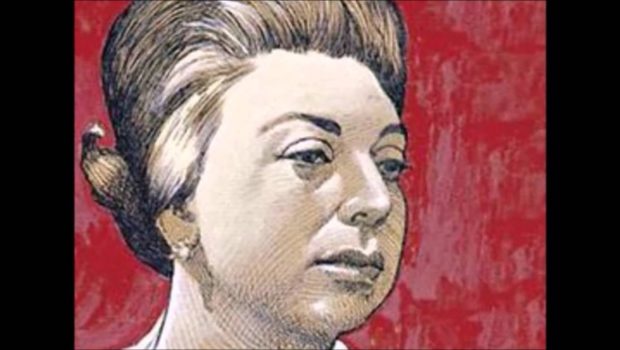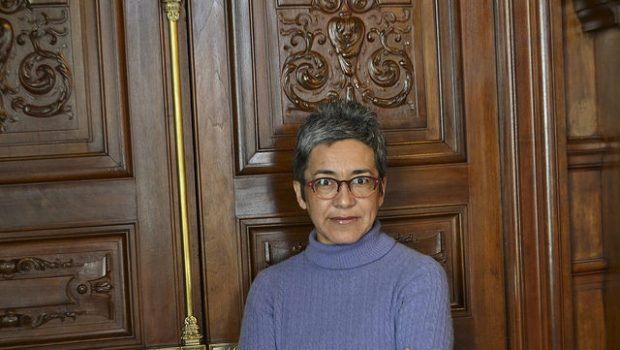“Cruzando puentes”… Literature as Translation
R. Lane Kauffmann
On this too rare occasion—the publication of an English-language anthology featuring selected poems and short fiction from a dozen of Spain’s best contemporary writers
—I have the pleasure of commenting on César Antonio Molina’s poem, “Cruzando Puentes,” translated into English by Francisco Macías. But before committing what Cleanth Brooks called “the heresy of paraphrase,” let me first recall Octavio Paz’s great essay on literary translation, in which he observes that translation is a universal human activity. All experience with language, even that of a young child, involves translation: “When we learn to speak, we are learning to translate; the child who asks his mother the meaning of a word is really asking her to translate the unfamiliar into the simple words he already knows. In this sense, translation within the same language is not essentially different from translation between two tongues, and the history of all peoples parallels the child’s experience.”
Also universal, Paz reminds us, is our experience of the foreignness and plurality of languages. At some point, through contact or closer acquaintance with other tongues, we become aware of the strange arbitrariness of our own language. But if there is no universal language, we can still learn to communicate and travel between and across cultures via the bridge of translation, if only because, as Paz reassures us with bracing optimism, “in any language [people] always say the same things.” Or at least, they did so once upon a time. In Paz’s telling, translation used to dispel the shadowy uncertainties of human experience by appealing to such notions as the “universality of [human] spirit”. That was until the “modern age” came along and robbed us of that comforting conviction. Paz’s essay provides a rough allegory of modernity as a facing-up-to and coming-to-terms with the increasing fragmentation and complication of experience. One needn’t read very far into Paz’s essay to realize that all creative writing is a kind of translation in Paz’s broad sense: a rendering of multifarious experience in the writer’s own idiom, and thus in a comprehensible meaning. The relative difficulty of much modern literature—and on this wide spectrum there are indeed many degrees of difficulty—may then be understood as writers’ unique responses to the challenge of representing and doing justice to the increasing complexity of experience.
Happily, Paz doesn’t dwell for long in the quagmire of poetry’s alleged untranslatability. Far from accepting that popular dogma (to which even Jakobson subscribed, though he was otherwise an optimist about the communicability of linguistic meaning), Paz argues for the translatability of poetry through a process that we may, somewhat oxymoronically, call creative fidelity. Like most of the bridges in Molina’s poem (particularly when read in a facing bilingual edition), poetry in Paz’s view is a two-way street which readers possessing sufficient bilingual and literary competence may traverse in either direction—that is, from the poet’s perspective, or from the translator’s. Paz explains that poetic translation is a procedure analogous and parallel to poetic creation, but one that “unfolds in the opposite direction”:
Poetry radically transforms language … in a direction opposite to that of prose… The poet, immersed in the movement of language [i.e., the mobility and interchangeability of signs]…chooses a few words, or is chosen by them … he constructs his poem, a verbal object made of now irreplaceable and immovable characters. The translator’s starting point is not the language in movement that provides the poet’s raw material, but the fixed language of the poem. A language congealed, yet living. His procedure is the inverse of the poet’s; he is not constructing an unalterable text from mobile characters; instead he is dismantling the elements of the text, freeing the signs into circulation, then returning them to language.
If one should ask what aim guides the translator’s procedure, enabling this “freeing” and “returning” of signs to be at once creative and faithful to the original poem, it may help to recall that in the same essay, Paz embraces Paul Valéry’s concise statement of the task of poetic translation: to produce “analogous effects with different implements.”
By way of segue to the “heretical” part of this commentary, I confess to having chosen to read and discuss “Cruzando puentes” on this occasion as much for rhetorical and pedagogical reasons as for aesthetic ones: not only because it pleases me as a poem, but also because its rich symbolism is fairly accessible. It evokes a particular experience of the poet’s at the same time that it expresses a well-nigh universal aspect of our contemporary experience of globalization. The metaphor of crossing bridges serves both the particularity and the universality in question, while it is also a plausible analogy for the practice of literary translation. Now let’s briefly see how Molina’s poem engages in this practice, crossing bridges both in literal and in figurative senses.
The poem begins in the autobiographical first person, declaring that the poet has crossed a series of the world’s famous bridges, and naming each bridge and its location in turn. (His examples are mainly in Europe and the Americas.) He goes on to narrate a particular crossing, one ostensibly “in progress” as he writes: the experience of crossing the Brooklyn Bridge on a certain day in 2004 (as one knows from external evidence to be adduced shortly). The specificity of the speaker’s experience is registered by many deictic markers in the poem: temporal and spatial locators such as “this”, “that”, “here,” “now”, verb tenses, and so on. Despite the situated singularity of this experience, the poet (more precisely, the poem’s speaking voice) reminds us again and again that he feels “suspended,” “immobile in the air, halfway between Manhattan and Brooklyn,” in the middle of the bridge (and perhaps of his life); at the midpoint, “a medio camino”; referring to a “suspension of the soul,” and enjoying the freedom of going forward or backward, a freedom that engages him, as it engages the reader. Anyone who has travelled for more than utilitarian purposes, and has gone for walks, and perhaps crossed actual bridges or other liminal spaces in a foreign country, has felt a similar sense of transition, of being somehow suspended between past and future, between one’s remembered home country and the surrounding unfamiliar, yet concretely present, place. This “no-man’s land” is “good medicine for the soul,” says the Spanish poet, recalling and echoing Whitman’s response to his own visit to the nearly completed bridge in 1878: “the best, most effective medicine my soul has yet partaken—the grandest physical habitat and surroundings of land and water the globe affords—namely, Manhattan island and Brooklyn, which the future shall join in one city—city of superb democracy, amid superb surroundings.”
The singular experience evoked in Molina’s poem is universalized by reminders that he is — in memory and imagination, those perpetual vehicles of mental travel—in the middle of “all the bridges in the world”; by frequent analogies (“I cross bridges as storms…as I leave dreams in hotels”); by existential and rhetorical questions (“Which will be the bridge of my dreams?” and “to which side will the [storms, bridges] cast us?”); by chiastic inversions such as “When I am weak, then I am strong; my strength is powerful in weakness”; by the meta-poetic truth that “Silence [not “The silence”, as one may quibble with the translator] belongs to the art of oratory”; and by the bemused query, with its Keatsian allusion, “¿Sueño despierto, o más bien despierto del sueño?”—another chiasmus or syntactic inversion, but one that doesn’t come through in Macías’s otherwise decent translation. To such paradoxical contrasts and crossings belongs the enigmatic final line of the poem: “My gaze is so innocent that it deceives.” This open ending leaves the reader wondering, just whom does the port’s gaze deceive—himself? The friends and passersby mentioned in the poem? The reader? And how does it deceive—deliberately, and therefore not innocently, or involuntarily, and thus not culpably? The poet, of course, knows better than to dissolve his own riddle by answering it in the poem.
Molina’s poem belongs to the poetry of place, of cityscapes, and in particular to that subgenre, the poet abroad who encounters and responds to the quintessential modern metropolis, New York City.
I was surprised and delighted to find, while browsing a thick volume of Molina’s collected travel essays, one piece that chronicles the experience recalled in this poem. It is entitled “Montague Street, Nueva York,” and is one of several pieces devoted to the poet’s forays in NYC, published in Molina’s collection, Lugares donde se calma el dolor (2009). In that essay the writer gives a learned, often poetic account of a particular walk that he took in NYC during 2004, a year, for him, of many crossed bridges. The surprising thing to me is that many of the key lines of the poem are embedded in this travel essay or chronicle, leaving the impression that the poem, “Cruzando puentes,” is culled from that prose piece. While this may sound as though I’m suggesting that Molina is a self-cannibalizer, that is far from the case. On the contrary, what these travel essays and many others like them reveal, in addition to Molina’s admirable familiarity with American literature, is something about his working method. It is fully a method of translation: the travel essays—erudite, informative, in some ways poetic in their own right (for example, in their paratactic construction)—are an initial translation of the poet’s experience, while the poem under discussion is a further translation, with distinct aims. This suggests that Molina is a writer of crossings in yet another sense. In his works, the genre differential—the prose-poetry distinction cited by Paz and presupposed by most readers—is no high wall but a bridging device, a well-placed passageway between discrete realms not ordinarily linked, guiding readers to and fro, enabling views and contrasts not ordinarily encountered on the same walk. A similar transversal principle is at work in Molina’s short narrative piece, “Bitter Lemons” (taken from his 2005 novel, Fuga de amor), which closes the timely anthology that we now celebrate. If Paz is right that all language is translation, to read César Antonio Molina, and the other authors represented in this anthology, is to be reminded that literature can be an especially intense and richly nuanced variant of that process.
Works cited
Aparicio, Javier, Aurelio Major, and Mercedes Monmany (eds.). Spain’s Great Untranslated. New York: Words Without Borders, 2013.
Brooks, Cleanth. The Well-Wrought Urn. New York: Harcourt Brace, 1947.
Jakobson, Roman. “On Linguistic Aspects of Translation.” In Lawrence Venuti (ed.), The Translation Studies Reader, 2nd ed. New York: Routledge, 2004. 138-43.
Molina, César Antonio. Fuga del amor. Barcelona: Ediciones Destino, 2005.
———-. Lugares donde se calma el dolor. Barcelona: Ediciones Destino, 2009.
———-. Selected Poems of César Antonio Molina. Trans. Francisco Macías Valdés. Edinburg: University of Texas Pan-American, 2012.
Neira, Julio (ed. and introd). Geometría angustia: Poetas españoles en Nueva York. Sevilla: Fundación José Manuel Lara, 2012.
Paz, Octavio. “Translation: Literature and Letters.” Trans. Irene del Corral. In Rainer Schulte and John Biguenet (eds.), Theories of Translation: An Anthology of Essays from Dryden to Derrida. Chicago: University of Chicago Press, 1992. 152–162.
Whitman, Walt. Prose Works. Philadelphia: David McKay, 1892; Bartleby.com, 2000. www.bartleby.com/229/ [Nov. 10, 2013].
Posted: December 9, 2013 at 12:26 am










